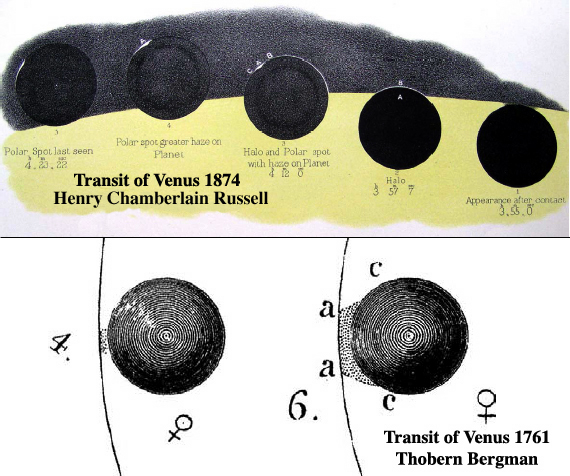
Fig 1. Historical observations of Venus atmospheric and "black drop" phenomena near transit contacts.
Glenn Schneider, Steward Observatory, University of Arizona
gschneider@as.arizona.edu,
http://nicmosis.as.arizona.edu:8000
in collaboration with Jay Pasachoff,
Williams College
Jay.M.Pasachoff@williams.edu
BACKGROUND INFORMATION & PROGRAM OBJECTIVES
Motivated by historical accounts of previously observed transits of
Venus (eg., Figure 1), and a desire to use the 8 June 2004 event as a
surrogate to test observing methods, strategies and techniques which
are being contemplated for future space missions to detect and
characterize extrasolar terrestrial planets as they transit their host
stars:
We used the Transition Region and Coronal Explorer (TRACE) Spacecraft to image
the 8 June 2004 Transit of Venus in "White Light", and at high temporal
cadence during (and flanking) the planet's crossing of the solar limb
and while on the heavily limb darkened portion of the solar disk.
Our primary programmatic objectives are:
(a) to image the circum-Cytherian "aureola" (eg., Russell, 1874; Fig 1 top) - sunlight scattered by aerosols and refracted in the back-lit planetary atmosphere - with high spatial resolution and image stability and morphologically and photometrically study its "temporal evolution" (i.e., the spatially resolved surface brightness distribution as functions of phase angle ["impact distance"] and circum-planetary azimuth angles) prior to Contact II and after Contact III. See Tanga (Laboratiore Cassiopee - Observatoire de la Cote d'Azure) for an excellent description of these phenomena based upon historical observations.
(b) to confirm with space-based imagery that the conjecture that ground-based historical reports of "Black Drops" (eg., Bergman, 1761; Fig1 bottom) at inner planet transits arose from the convolution of the instrumental (telescopic/optical) plus atmospheric point spread function in conjunction with the limb-darkened photospheric illumination function (see Schneider, Pasachoff and Golub, 2004, Icarus, 168, 249), and investigate the detectability of circum-planetary refracted light during photospheric transit.

Fig 1. Historical observations of Venus atmospheric and "black drop"
phenomena near transit contacts.
OBSERVATION DESCRIPTION
WAVELENGTH: All images (for our program) were obtained in TRACE's
"White Light" (WL) configuration, which provides spectral sensitivity
in the wavelength range from 1200 - 9600 Angstroms. The TRACE WL
instrumental response to an un-limb darkened solar spectral energy
distribution,
peaking 6000-8000 Angstroms, is shown HERE.
SPATIAL SCALE AND RESOLUTION: During the transit, Venus's angular
diameter was app. 58.2 arcseconds (12,104 km at 0.289 AU),
diametrically spanning
116 detector pixels. The TRACE WL spatial resolution is
Nyquist-limited by its 0.5" per pixel sampling of its CCD, not
diffraction limited by the 30 cm. telescope. With a WL pivot
wavelength of 6200 Angstroms, Venus was resolved by app 60
band-integrated resolution elements.
TEMPORAL CADENCE: With a desire for high inter-frame temporal cadence in highest fidelity data format (i.e., "lossless" or uncompressed), particularly during and near the limb contacts, we read out only a 512x512 sub-array of the 1024x1024 CCD detector due to both downlink bandwidth and memory [image buffer] limitations. Our observations were interleaved with observations taken for other programs (with other TRACE filters and data formats), thus the inter-frame temporal spacing was not uniform throughout our imaging sequences. During ingress we achieved a cadence of five frames per minute (uniformly spaced) across the limb contacts, but at a reduced rate of app two frames per minute at other times. At egress we obtained images at CIII +/- app 3 minutes at a (uniformly spaced) rate of 7 frames per minute, but at a slower rate of app one frame every 35s when the leading edge of Venus was further from the solar limb. Some technical details of the as-planned observing program may be found here.
IMAGES, "MOVIES", AND STEREOGRAMS
We present here the first photometrically rigorous results from the INGRESS and EGRESS imaging sequence taken in TRACE's WL pass band. The TRACE WL optical channel, so we discovered, suffers from an app 1% intensity optical "ghosting." Normally, this is not of concern for TRACE's solar observation programs, but as our interest rests primary in the "bottom" 1% of the (12 bit) dynamic sampling range, this presented a significant photometric "challenge." With detailed characterization we found the "ghost" to be double, with different degrees of afocality and intensity, plus an additional diffuse (not afocally specular) component more difficult to analytically characterize. For each frame, we built and subtracted models of the instrumentally scattered light to remove these artifacts (examples of this will be added later). The images presented here have been post-processed in this manner, and while not "perfect" this very effectively mitigates the instrumentally ghosted/scattered light. This procedure, however, cannot recover intensity information with sufficient photometric precision in an app 2 pixel (1.0" - 1.5") wide region exterior to the photosphere where the solar limb is bifurcated by the Cytherian disk. This is the reason for the "gap" you will note in the image of Venus presented below as it transits the solar limb.
Image Orientation: North is "up" in all of the downloadable images
and movies presented here.
Click HERE to view "3D"
stereograms
of the transit made from selected TRACE imaging frames.
The ingress sequence is comprised of 98 frames from 050553 UT
to 054751 UT. The egress sequence is comprised of 84 frames 105231 UT
to 112315 UT.
Both sequences have been assembled into Quicktime movies (Fig 3), with
a
playback rate of 10 frames per second. To view/download the movies
(21/24 Mbytes each, respectively) rendered as 8-bit (256 level
grayscale) click on the title frames below. Higher fidelity
versions of the movie (42/48 Mbytes each) rendered as 16-bit (32K level
grayscale) may be downloaded HERE.
(Need a QuickTime viewer? Go HERE - even
Windoze
folks).
Click on Movie Title Frames (below) to
View 8-bit Movies
 |
 |
 |
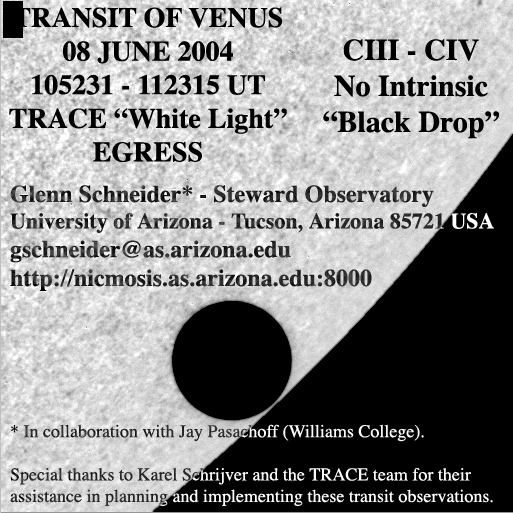 |
 |
 |
Below, we have extracted and show several frames from the INGRESS and
EGRESS movies, with explanation of the display format and comments on
the images below.
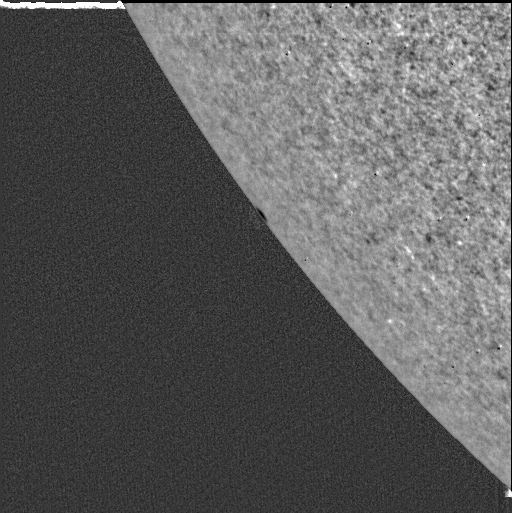 050628 UT - First Contact |

052010 UT - Geometrical Mid Transit |
 052727 UT - Contiguous Atmospheric Scattered-Light Arc |
 053309 UT - Atmosphere Brightens with Decreasing Limb Distance |
 053706 UT - Approaching Second Contact |
 053850 UT - SECOND CONTACT - No Intrinsic "Black Drop"! |
 053850 UT - SECOND CONTACT - PSF Broadening IS Seen |
 053924 UT - Clean Separation - The Trek Across the Photosphere Begins |
 105849UT - Intra-limb PSF convolution darkening seconds before CIII |
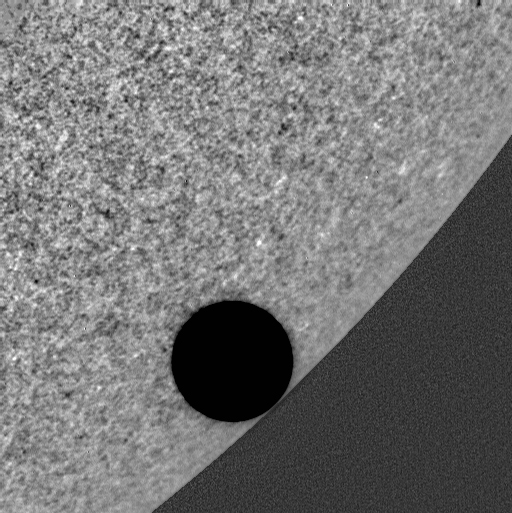 105849 UT - (harder display stretch) - No Intrinsic
"Black Drop"!
|
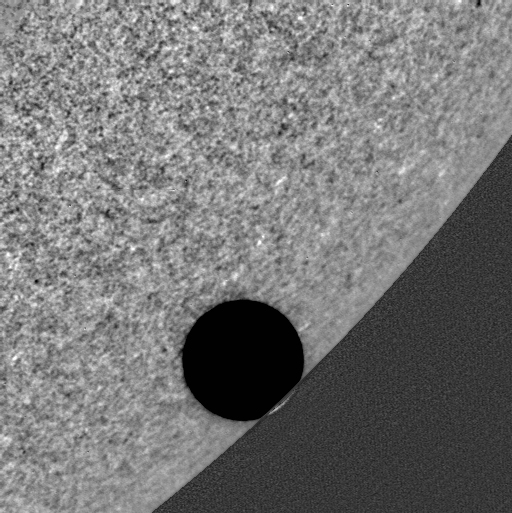 105949 UT (one minute later) - Venus
atmosphere easily visible & asymmetric 105949 UT (one minute later) - Venus
atmosphere easily visible & asymmetric |
 110235 UT - Bi-lateral azimuthal asymmetry
in atmospheric arc 110235 UT - Bi-lateral azimuthal asymmetry
in atmospheric arc |
 110823 UT - Halfway through egress, half the arc remains |
 112239UT - Contact IV and a small piece of the arc is still visible (see movie) |